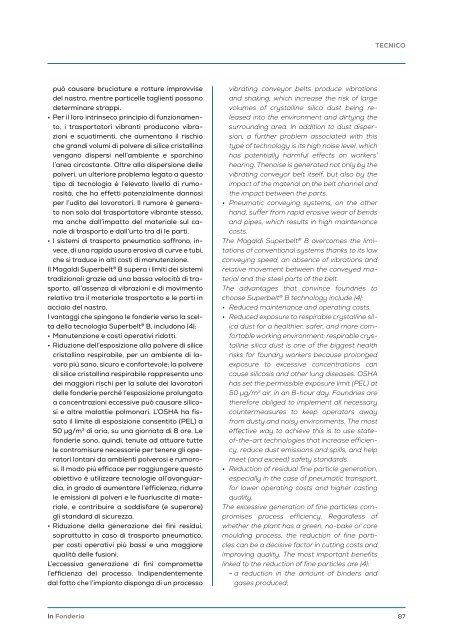In Fonderia 1 2024
Primo numero del 2024 di In Fonderia
Primo numero del 2024 di In Fonderia
Create successful ePaper yourself
Turn your PDF publications into a flip-book with our unique Google optimized e-Paper software.
TECNICO<br />
può causare bruciature e rotture improvvise<br />
del nastro, mentre particelle taglienti possono<br />
determinare strappi.<br />
• Per il loro intrinseco principio di funzionamento,<br />
i trasportatori vibranti producono vibrazioni<br />
e scuotimenti, che aumentano il rischio<br />
che grandi volumi di polvere di silice cristallina<br />
vengano dispersi nell’ambiente e sporchino<br />
l’area circostante. Oltre alla dispersione delle<br />
polveri, un ulteriore problema legato a questo<br />
tipo di tecnologia è l’elevato livello di rumorosità,<br />
che ha effetti potenzialmente dannosi<br />
per l’udito dei lavoratori. Il rumore è generato<br />
non solo dal trasportatore vibrante stesso,<br />
ma anche dall’impatto del materiale sul canale<br />
di trasporto e dall’urto tra di le parti.<br />
• I sistemi di trasporto pneumatico soffrono, invece,<br />
di una rapida usura erosiva di curve e tubi,<br />
che si traduce in alti costi di manutenzione.<br />
Il Magaldi Superbelt ® B supera i limiti dei sistemi<br />
tradizionali grazie ad una bassa velocità di trasporto,<br />
all’assenza di vibrazioni e di movimento<br />
relativo tra il materiale trasportato e le parti in<br />
acciaio del nastro.<br />
I vantaggi che spingono le fonderie verso la scelta<br />
della tecnologia Superbelt ® B, includono |4|:<br />
• Manutenzione e costi operativi ridotti.<br />
• Riduzione dell’esposizione alla polvere di silice<br />
cristallina respirabile, per un ambiente di lavoro<br />
più sano, sicuro e confortevole; la polvere<br />
di silice cristallina respirabile rappresenta uno<br />
dei maggiori rischi per la salute dei lavoratori<br />
delle fonderie perché l’esposizione prolungata<br />
a concentrazioni eccessive può causare silicosi<br />
e altre malattie polmonari. L’OSHA ha fissato<br />
il limite di esposizione consentito (PEL) a<br />
50 μg/m 3 di aria, su una giornata di 8 ore. Le<br />
fonderie sono, quindi, tenute ad attuare tutte<br />
le contromisure necessarie per tenere gli operatori<br />
lontani da ambienti polverosi e rumorosi.<br />
Il modo più efficace per raggiungere questo<br />
obiettivo è utilizzare tecnologie all’avanguardia,<br />
in grado di aumentare l’efficienza, ridurre<br />
le emissioni di polveri e le fuoriuscite di materiale,<br />
e contribuire a soddisfare (e superare)<br />
gli standard di sicurezza.<br />
• Riduzione della generazione dei fini residui,<br />
soprattutto in caso di trasporto pneumatico,<br />
per costi operativi più bassi e una maggiore<br />
qualità delle fusioni.<br />
L’eccessiva generazione di fini compromette<br />
l’efficienza del processo. <strong>In</strong>dipendentemente<br />
dal fatto che l’impianto disponga di un processo<br />
vibrating conveyor belts produce vibrations<br />
and shaking, which increase the risk of large<br />
volumes of crystalline silica dust being released<br />
into the environment and dirtying the<br />
surrounding area. <strong>In</strong> addition to dust dispersion,<br />
a further problem associated with this<br />
type of technology is its high noise level, which<br />
has potentially harmful effects on workers’<br />
hearing. Thenoise is generated not only by the<br />
vibrating conveyor belt itself, but also by the<br />
impact of the material on the belt channel and<br />
the impact between the parts.<br />
• Pneumatic conveying systems, on the other<br />
hand, suffer from rapid erosive wear of bends<br />
and pipes, which results in high maintenance<br />
costs.<br />
The Magaldi Superbelt ® B overcomes the limitations<br />
of conventional systems thanks to its low<br />
conveying speed, an absence of vibrations and<br />
relative movement between the conveyed material<br />
and the steel parts of the belt.<br />
The advantages that convince foundries to<br />
choose Superbelt ® B technology include |4|:<br />
• Reduced maintenance and operating costs.<br />
• Reduced exposure to respirable crystalline silica<br />
dust for a healthier, safer, and more comfortable<br />
working environment; respirable crystalline<br />
silica dust is one of the biggest health<br />
risks for foundry workers because prolonged<br />
exposure to excessive concentrations can<br />
cause silicosis and other lung diseases. OSHA<br />
has set the permissible exposure limit (PEL) at<br />
50 µg/m 3 air, in an 8-hour day. Foundries are<br />
therefore obliged to implement all necessary<br />
countermeasures to keep operators away<br />
from dusty and noisy environments. The most<br />
effective way to achieve this is to use stateof-the-art<br />
technologies that increase efficiency,<br />
reduce dust emissions and spills, and help<br />
meet (and exceed) safety standards.<br />
• Reduction of residual fine particle generation,<br />
especially in the case of pneumatic transport,<br />
for lower operating costs and higher casting<br />
quality.<br />
The excessive generation of fine particles compromises<br />
process efficiency. Regardless of<br />
whether the plant has a green, no-bake or core<br />
moulding process, the reduction of fine particles<br />
can be a decisive factor in cutting costs and<br />
improving quality. The most important benefits<br />
linked to the reduction of fine particles are |4|:<br />
- a reduction in the amount of binders and<br />
gases produced;<br />
<strong>In</strong> <strong>Fonderia</strong><br />
87














